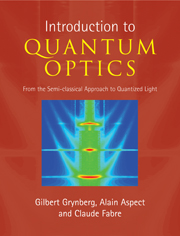Book contents
- Frontmatter
- Contents
- Foreword
- Preface
- Acknowledgements
- Part I Semi-classical description of matterlight interaction
- Part II Quantum description of light and its interaction with matter
- 4 Quantization of free radiation
- Complement 4A: Example of the classical Hamiltonian formalism: charged particle in an electromagnetic field
- Complement 4B: Momentum and angular momentum of radiation
- Complement 4C: Photons in modes other than travelling plane waves
- 5 Free quantum radiation
- Complement 5A: Squeezed states of light: the reduction of quantum fluctuations
- Complement 5B: One-photon wave packet
- Complement 5C: Polarization-entangled photons and violation of Bell's inequalities
- Complement 5D: Entangled two-mode states
- Complement 5E: Quantum information
- 6 Interaction of an atom with the quantized electromagnetic field
- Complement 6A: Hamiltonian formalism for interacting fields and charges
- Complement 6B: Cavity quantum electrodynamics
- Complement 6C: Polarization-entangled photon pairs emitted in an atomic radiative cascade
- Part III Applying both approaches
- Index
Complement 5C: Polarization-entangled photons and violation of Bell's inequalities
Published online by Cambridge University Press: 05 August 2012
- Frontmatter
- Contents
- Foreword
- Preface
- Acknowledgements
- Part I Semi-classical description of matterlight interaction
- Part II Quantum description of light and its interaction with matter
- 4 Quantization of free radiation
- Complement 4A: Example of the classical Hamiltonian formalism: charged particle in an electromagnetic field
- Complement 4B: Momentum and angular momentum of radiation
- Complement 4C: Photons in modes other than travelling plane waves
- 5 Free quantum radiation
- Complement 5A: Squeezed states of light: the reduction of quantum fluctuations
- Complement 5B: One-photon wave packet
- Complement 5C: Polarization-entangled photons and violation of Bell's inequalities
- Complement 5D: Entangled two-mode states
- Complement 5E: Quantum information
- 6 Interaction of an atom with the quantized electromagnetic field
- Complement 6A: Hamiltonian formalism for interacting fields and charges
- Complement 6B: Cavity quantum electrodynamics
- Complement 6C: Polarization-entangled photon pairs emitted in an atomic radiative cascade
- Part III Applying both approaches
- Index
Summary
Entanglement is one of the most surprising features of quantum mechanics. However, it was not until the last decades of the twentieth century that its full importance was understood and it was realized that it could lead to revolutionary applications in the area of quantum information. It was A. Einstein who discovered the extraordinary properties of non-factorizable two-particle states, when seeking to demonstrate that the formalism of quantum mechanics is incomplete. He presented his findings in 1935 in his famous article published jointly with B. Podolsky and N. Rosen, now referred to as the ‘EPR’ paper. Soon afterwards, Schrödinger coined the term ‘entangled states’ to emphasize the fact that the properties of the two particles are inextricably bound together.
In the EPR article, Einstein and his colleagues used quantum predictions to conclude that the formalism of quantum mechanics was incomplete, in the sense that it did not account for the whole of physical reality, and that the task of physics was therefore to find a more complete theory. They did not contest the validity of the quantum formalism, but suggested that a further, more detailed level of description would have to be introduced, in which each particle of the EPR pair would have well-defined properties that were not taken into account in the quantum formalism.
- Type
- Chapter
- Information
- Introduction to Quantum OpticsFrom the Semi-classical Approach to Quantized Light, pp. 413 - 433Publisher: Cambridge University PressPrint publication year: 2010

